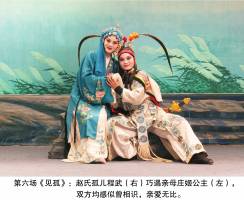Scenario
The Orphan of Zhao is a play based on historical records. The orphan was born circa 583 BC during the Spring-Autumn Period – a time when imperial power was being eroded by the growth of numerous aristocratic-family-states. Appalled by the chaos and bloodshed, philosophers such as Confucius (551-479 BC) acted as advisors to rulers on how to control their states and people.
Historical records present contradictory accounts of the story. Most versions of different theatrical genres and films we see now are based on the extant full-length tragedy Wrongs Avenged by the Orphan of Zhao by Ji Junxiang, written in the Yuan dynasty when China was ruled by the Mongols (1279-1368 AD).
The basic story is as follows: schemed by the evil courtier Tu’an Gu, the Zhao clan were all killed except for the Princess who was the Jin Ruler’s sister and was pregnant. After the baby was born, he was smuggled out by a doctor called Cheng Ying. Having realized that the baby boy had escaped, Tu’an Gu gave the order to kill all the newly born boys in the country. Finally, Cheng Ying decided to give up his own child for the Zhao orphan. Meanwhile Cheng Ying and his friend, a retired minister Gongsun Chujiu made a plan. Cheng would report to Tu’an about Gongsun who had the Zhao orphan in his house. Actually the real Zhao orphan was hidden in the deep mountain while Cheng’s own baby son was with Gongsun. Tu’an killed both Gongsun and the child. In order to reward Cheng Ying as a loyal reporter, Tu’an took both Cheng Ying and his son (but actually Zhao’s offspring) to his house and Tu’an made himself the foster father of the boy.16 years later, Cheng Ying revealed the true story to the young man. The orphan of Zhao took the revenge on Tu’an, for his parents, grandparents, his clan and for Cheng Ying. In order to rescue this orphan many people died.
This is an archetypal Chinese story of loyalty, honesty, sacrifice, friendship, evil, revenge, bravery, and justice.
The hubei huaguxi clip is a special piece that the Hubei Provincial Huaguxi Research Institute made for the Leeds international symposium Performing China on the Global Stage, held in March 2013. It shows the full last scene of the production: Cheng Ying and his wife come to Gongsun Chujiu’s tomb to say goodbye. They have returned the grown-up orphan of Zhao to his Princess mother, refused any reward from the court, and have decided to leave the palace. The young man comes to beg the couple to stay, but they are determined to leave. They want a quiet space to mourn their own son whom they sacrificed for rescuing the orphan of Zhao.
Images and the video are courtesy of Hubei Provincial Experimental Huaguxi Theatre & Hubei Provincial Huaguxi Research Institute.
剧情简介:
《赵氏孤儿》是一个春秋时代的故事。据史书记载,孤儿出生于公元前583年左右。当时受到“分封制”诸侯日益强大势力的侵蚀,周王权日益衰微,诸侯争霸称雄,战争与血腥屠杀连年不断。同时,诸子百家学说开始出现,并试图就如何管理国家和人民等等给予统治者以哲学性的思考。
史书有着互相矛盾的关于赵氏孤儿的记载。我们现在所看到的各种戏剧形式和电影版本基本上来自于元代纪君祥的《冤报冤赵氏孤儿》。
大致故事如下:奸臣屠岸贾设计将与自己不和的赵氏家族满门抄斩,唯一幸免的是已有身孕的、赵朔的妻子庄姬,她是晋王室的公主。男婴出生以后,就被一位叫作程婴的医生想办法带出了宫苑。当屠岸贾听说婴儿已经逃遁,便下令杀死举国上下所有在这段时期内出生的男婴。几经考量,程婴决定献出自己的亲生儿子以保全赵家唯一的骨血。与此同时,程婴和老友、已经告老还家的公孙杵臼安排了救孤的计划。程婴前往屠岸贾处报告公孙杵臼藏匿了赵氏的孤儿,而实际上,真正赵家的孤儿被藏在深山之中,而公孙那里的婴儿恰恰是程婴自己的孩子。屠岸贾杀死了公孙杵臼和婴儿,为报答程婴举报之功,他把程婴及其儿子(是真正的赵氏孤儿)接回自己家里,好生款待,并把男孩作为自己的养子来呵护养育。孤儿长大成人以后,程婴将孤儿的身世告诉了他本人。为给自己的父母、祖父母、赵氏家族以及为程婴报仇,孤儿杀死了屠岸贾。为了拯救孤儿,诸多英雄献出自己的生命。
《赵氏孤儿》是关于忠义、诚信、牺牲、友情、奸佞、报仇、勇猛和正义的中国原型。
这一湖北花鼓戏的片断选自最后一场。程婴和老妻前往公孙杵臼墓前祭奠并辞行。他们已经把抚养成人的孤儿归还了公主,也拒绝了所有高爵厚禄的奖赏,他们将回到自己的家乡去。孤儿前来央告老人继续留下来,但是程婴夫妇决心已定。他们要到自己的家里去,静静地思念当初为了拯救赵氏孤儿而牺牲的亲生儿子。
诚挚感谢湖北省实验花鼓戏剧院与湖北省花鼓戏艺术研究院提供图片与录像。


